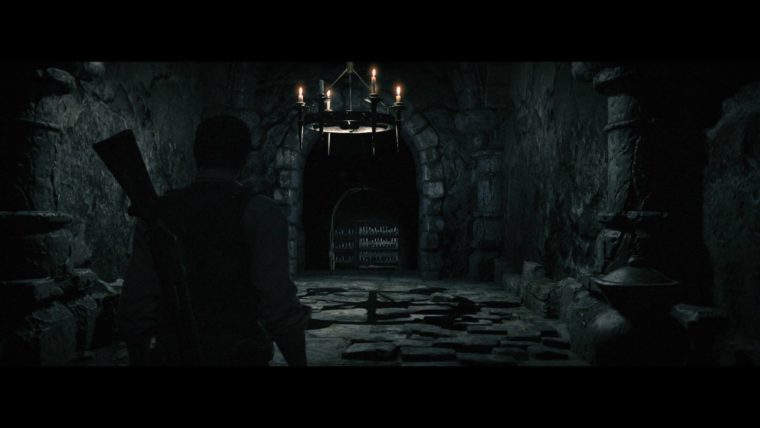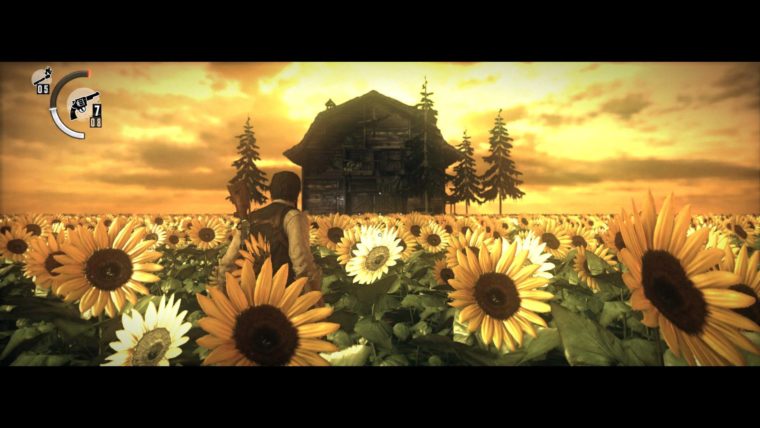The Evil Within marks the return of Shinji Mikami to the survival-horror genre, which he helped to pioneer with his early creation, Resident Evil. This, of course, brings with it a lot of anticipation and expectation from the fans who have followed his work for many years. With the overall decline of the survival-horror genre, largely thanks to the later, non-Mikami developed RE games focusing on more action-heavy gameplay, fans felt like they had been abandoned by AAA developers. The Evil Within is an attempt to fix that by bringing back those bone-chilling scares we all remember so fondly. Unfortunately, the scares never really arrive, and players are left more frustrated than afraid. While The Evil Within largely fails to live up to this goal that doesn’t necessarily make it a bad game in its own right.
One of the first thing players will notice while playing The Evil Within is the use of the extremely odd aspect ratio. Inspired by films, the game uses a wide viewing area by adding black bars to the top and bottom of the screen, which limits your sense of the surroundings to a great degree. Attempting to cause fear through the unknown, this is a logical evolution of the forced-perspective featured in the Resident Evil series. Without a doubt, the shift takes quite a bit of getting used to, but after many hours with the game it feels like a bad decision. The overall effect is one of fear through frustration since any time it actually affects the player it is due to a cheap attack or surprise from slightly off-camera. This taste for the unique extends elsewhere in the game, but doesn’t seem to have impacted the story.

The Evil Within places you in the shoes of Krimson City Detective Sebastian “Seb” Castellanos. The game opens with Seb and his partners investigating a grisly murder scene at the local mental hospital. After a mysterious figure attacks the group they find themselves lost in a strange world that is populated with all the standard horror fare. Zombies, ghouls, and other monsters besiege our hero as he tries to unravel the mystery surrounding his current predicament and the disappearances that have plagued the city for years. Of course, this will inevitably bring up his own personal demons along the way, as Seb comes to terms with his past tragedies.
The story is intriguing enough, featuring a few twists and turns along its long path, but overall it isn’t anything we haven’t seen before in the genre. This issue is compounded due to the opening hours featuring little in the way of explanation or structure. The player is thrown from location to location at whim, with some transitions occurring in the middle of a hallway. These quick jumps in location can be enjoyable the first few times, but confusion quickly sets in as it happens more and more. Being confused can enhance the scariness of a situation, but, much like the aspect ratio, that fear turns to frustration as the player is sent from one set-piece to another with little reason conveyed. Thankfully these varying set-pieces offer up a great amount of unique locations for you to explore. One level will be in a small mountain village, the next a cliffside bunker, and another in a very familiar mansion in the woods. While the jarring nature of the jumps may disappoint, the design and overall variety does not.
This focus on variety extends to the enemies of The Evil Within as well, with many standouts that could easily become horror icons with more focus. Of course, there are the standard zombies littering the landscape, but they are turned up to eleven with added touches like spikes and barb-wire. It might become a bit much for some players, feeling like the designers just through everything they had at the character, but overall it felt like a nice way to break away from the zombie pack. On top of these come less common enemies, like the double-headed creatures that populate the cave level, along with some truly memorable bosses. Of course, we’ve all seen Boxhead already, but he isn’t alone and you’ll find the most fear will come with the introduction of a new boss.

Some stages felt more like an action game as I felt fine walking around, blasting enemies with my guns
While the visuals and design of the enemies is interesting, the way you take them down is nothing you haven’t experienced before. With Shinji Mikami’s return many were anticipating combat and gameplay in-line with the early Resident Evil games, instead The Evil Within leans more toward Resident Evil 4. This isn’t a bad thing at all, in fact RE4 was easily one of the best games of all time, but that gameplay has been copied so much at this point that it has become passe. Essentially, The Evil Within plays like a normal third-person shooter, only with a little less ammo and supplies. You’ll use a pistol, shotgun, sniper rifle, and grenades to take out the monsters that wish to do you harm. By far, the most interesting addition to the normal roster of weapons is the Agony Bow. This crossbow fires different types of bolts, which can be found in the level or crafted using parts. You can find these parts scattered about or salvage them from traps that are placed within the levels. These traps also come into play in combat, as you can lure enemies into them, which results in some of the best moments that The Evil Within has to offer.
This is especially helpful early on as near the beginning of the game you will be very inaccurate and do little damage, causing even regular enemies to be bullet sponges. To get around this you can attempt a stealth kill, but enemies seem to be able to spot you through walls and around corners making this less than ideal. Alternatively you can knock them down and set them on fire using matches if you have some available. This becomes less of a necessity later on as all of your weapons, along with your own stats and abilities, can be upgraded using brain juice found throughout the levels. Upgrades and mid-chapter saving are handled with visits to the psych ward, a mysterious location that Seb can transport to via broken mirrors. None of the upgrades change up the gameplay all that much, but they help make the later stages more enjoyable as you need to worry less about common enemies. However, this can be a problem since you feel less afraid as you wander the corridors. Some stages felt more like an action game as I felt fine walking around, blasting enemies with my guns, with the only concern being my dwindling ammunition. That fear will crop up occasionally though, since many enemies and traps will kill you with a single hit. This is yet another instance of the fear through frustration that is almost a running theme of The Evil Within. As the game continued on I found myself only afraid of the enemies insofar as they could pop up, kill me immediately, and send me back to a checkpoint. Thankfully there are enough checkpoints to make this less of an issue, but some areas were too far spaced out causing immediate anger after a cheap death.

All of these deaths are shown off in great, gory detail of course. In fact, gore seems to be the main focal point of The Evil Within, with the character being literally bathed in blood on multiple occasions. Entire sections of the game have piles of bodies strewn about, as the player works to add to the pile. This focus on extreme, over-the-top gore might please some players, but it borders on becoming comical as the sheer amount of death is thrust upon you. The fact that the main character never actually reacts in a logical manner to his surroundings only adds to this humorous effect, as you watch bodies get shredded only to have Seb move on without comment. I don’t want him to be a whimpering, cowering mess, but a little acknowledgement that swimming through a vat of blood is not a normal occurrence would be nice.
The Verdict
The Evil Within does bring back a few elements that made classic survival-horror games fun, but they are overshadowed by the missteps along the way. Instead of creating a genuinely fearful environment, the game simply attempts to frustrate the player and hopes that this will result in the desired effect. Still, the gameplay might not be unique, but it is solid and enjoyable in its own way, and the wildly varying level and character designs helps to create a game that keeps you coming back just to see what will be around the next corner. If only the shifts had been better explained along the way, players might be able to enjoy the ride a little bit more.











Published: Oct 23, 2014 11:45 am